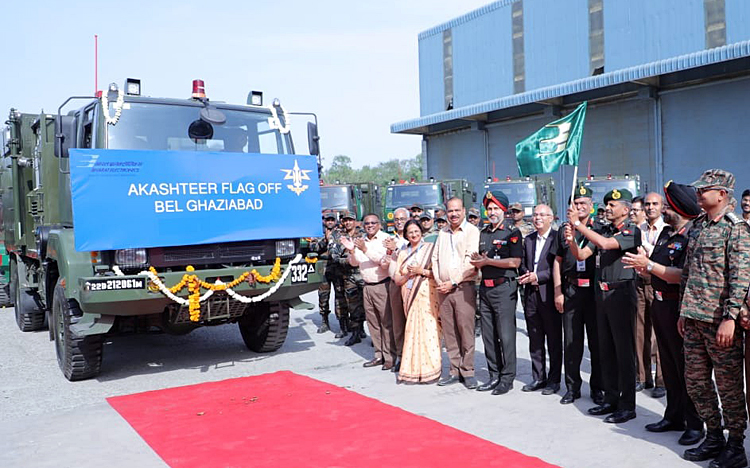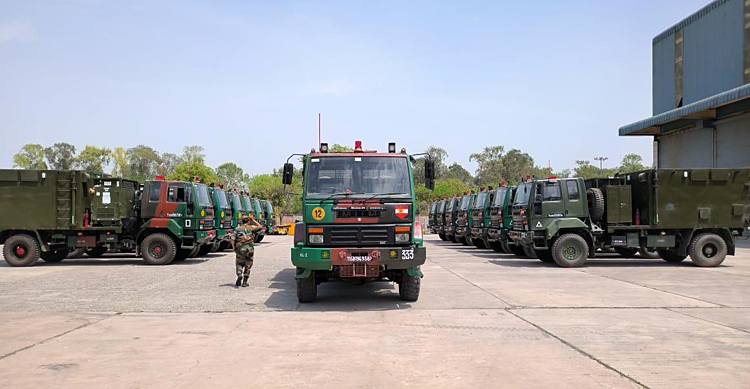INDIAN ARMED FORCES CHIEFS ON OUR RELENTLESS AND FOCUSED PUBLISHING EFFORTS

The insightful articles, inspiring narrations and analytical perspectives presented by the Editorial Team, establish an alluring connect with the reader. My compliments and best wishes to SP Guide Publications.

"Over the past 60 years, the growth of SP Guide Publications has mirrored the rising stature of Indian Navy. Its well-researched and informative magazines on Defence and Aerospace sector have served to shape an educated opinion of our military personnel, policy makers and the public alike. I wish SP's Publication team continued success, fair winds and following seas in all future endeavour!"

Since, its inception in 1964, SP Guide Publications has consistently demonstrated commitment to high-quality journalism in the aerospace and defence sectors, earning a well-deserved reputation as Asia's largest media house in this domain. I wish SP Guide Publications continued success in its pursuit of excellence.
- Operation Sindoor: Resolute yet Restrained
- India’s Operation Sindoor Sends a Clear Message to Terror and the World – ‘ZERO TOLERANCE’
- Japan and India set forth a defence cooperation consultancy framework, talks on tank and jet engines
- Terrorist Attack in Pahalgam in Kashmir: Unfolding a long surgical war against PAK
- Lt General Pratik Sharma takes over Command of Indian Army's Northern Command
The Akashteer-IACCS Combo
Indian Army and the IAF are actively working towards enhancing their joint operational capabilities in air defence with the integration of the Army's 'Akashteer' air defence system with the Integrated Air Command & Control System (IACCS), an automated Air Defence Command and Control Centre for controlling and monitoring of air operations by the IAF
 |
The Author is Former Director General of Information Systems and A Special Forces Veteran, Indian Army |

The first Chief of Defence Staff (CDS) General Bipin Rawat, after assuming his appointment in January 2020, had proposed the establishment of an integrated military command that would coordinate air defence operations of the Indian Military. Following discussions on the issue, a unified tri-service air defence command was thought of. The Air Defence Command was to be headed by a three-star Indian Air Force (IAF) officer. It was decided that the outline blueprint for this proposed command would be as decided that a proposal to create such a command would be prepared by June 30, 2020. Work on creating the Air Defence Command was subsequently scheduled to start in 2021.
Through the IACCS, IAF will connect all of its space, air and ground assets quickly, for total awareness of a region
Thereafter, there was no news till June 2023 when it was confirmed that the proposal to establish the Air Defence Command had been shelved; since it was felt that establishing a separate Air Defence Command would be counterproductive because air defence and offensive air operations are inter-dependent. The IAF also cited that dividing limited air assets into separate commands would be unwise. This command would have been responsible for air defence operations of the Indian military; integrating all the relevant assets of three services under a single command authority.

Recent news reports of January 21, 2025 indicate that the Indian Army and the IAF are actively working towards enhancing their joint operational capabilities in air defence. This initiative includes the integration of the Army's 'Akashteer' air defence system with the Integrated Air Command & Control System (IACCS), which aims to improve coordination and effectiveness in air defence operations.
IACCS is an automated Air Defence Command and Control Centre for controlling and monitoring of air operations by the IAF. Through the IACCS, IAF will connect all of its space, air and ground assets quickly, for total awareness of a region; offering connectivity for all the ground platforms and airborne platforms (including AEW&C), as a part of the network centricity of the IAF.
Project Akashteer automates and integrates air defence control processes, enhancing situational awareness and reducing the risk of friendly fire incidents
Defence Minister Rajnath Singh familiarised with the IACCS when he visited a premier radar station of the IAF on August 30, 2022, where various networked operation of the IACCS were demonstrated to him covering varied locations across the country. The IAF in a statement said, "The system (IACCS) is the backbone of IAF's march towards network centricity and is a key enabler in operations. The system's capabilities endow its users with an enhanced situational awareness that reduces IAF's sensor-to-shooter loop. The robust system has redundancies built into its functioning which enable seamless operations between its assets across the country. These included the networked and synergised operations of fighter, transport and Remotely Piloted aircraft." The defence minister was also briefed about the nuances of peacetime Command and Control functions which include ensuring the air defence of critical areas on a day-to-day basis, as well as during large events. In his address, Defence Minister Rajnath Singh complimented the air warriors for keeping the nations' skies safe throughout the year.
According to media reports, the integration of the Akashteer system with IACCS has been completed for one site in January 2025, while efforts are ongoing to integrate additional sites. This integration is crucial for achieving a unified air defence strategy that leverages both Army and Air Force assets. Project Akashteer represents a significant advancement in India's air defence capabilities. It automates and integrates air defence control processes, enhancing situational awareness and reducing the risk of friendly fire incidents. The system incorporates various radar and communication technologies into a cohesive network, allowing for more effective detection and engagement of hostile targets. The media report goes on to say that recently a four-day joint exercise named Exercise Devil Strike was conducted to validate these integrated operations. The exercise involved complex airborne operations and demonstrated the ability of both forces to operate seamlessly in challenging environments. This drill not only tested operational preparedness but also refined logistic strategies to maintain troop effectiveness under extreme conditions.
By combining resources and capabilities, the Army and IAF aim to create a more responsive and resilient air defence posture
The report goes on to say that the move towards jointness in air defence is seen as a critical step in enhancing India's military readiness. By combining resources and capabilities, the Army and IAF aim to create a more responsive and resilient air defence posture. The Akashteer system's automation and integration promise to streamline operations, ensuring rapid responses to aerial threats while safeguarding friendly aircraft in contested airspace.
Finally, the government intent is apparent in giving the push for integrated theatre commands. The CDS General Anil Chauhan has stated that presenting the blueprint of theatre commands to the government is his priority. This is despite the IAF's combat strength down to around 30 fighter jet squadrons against the authorized strength of 42 squadrons. At the same time, the CDS has also said that the IAF could take control of the air assets of the Indian Navy, if the need arose. The question, therefore, is whether the case for establishing a tri-service Air Defence Command needs to be revisited.





